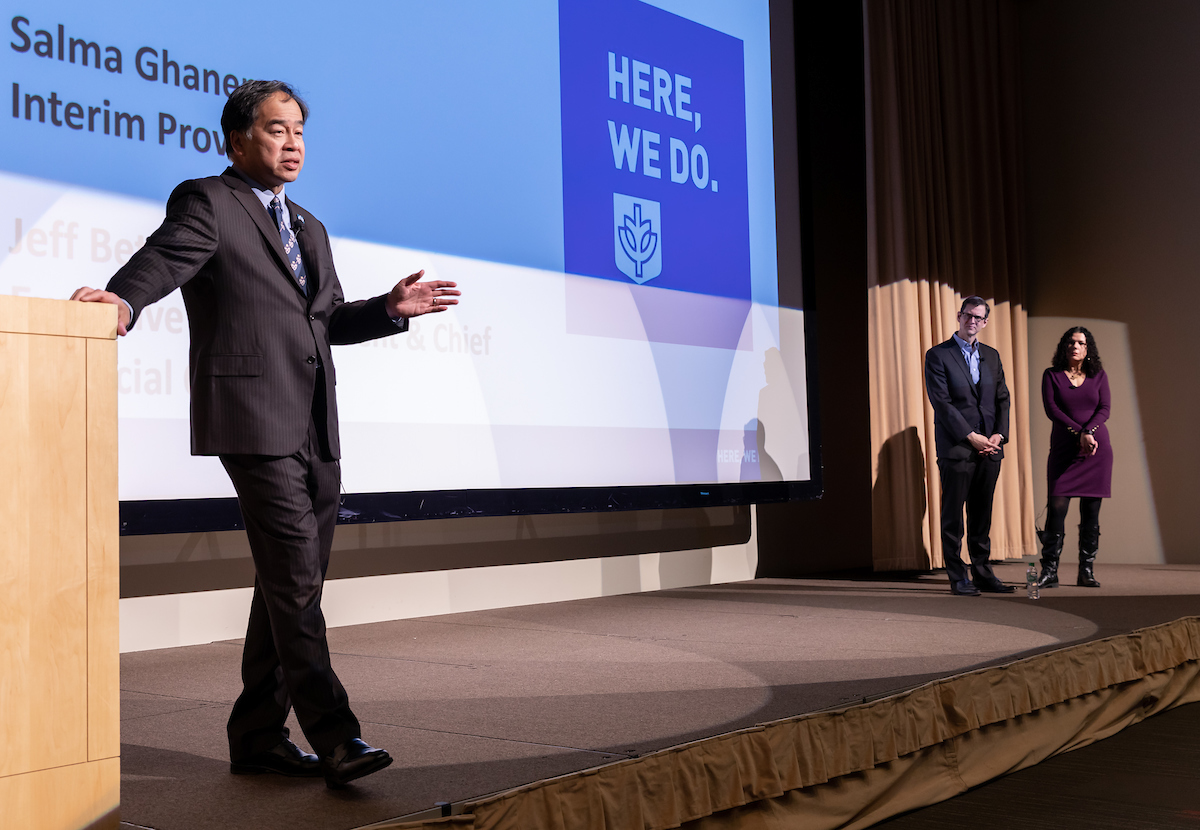 (DePaul University/Jeff Carrion)
(DePaul University/Jeff Carrion)DePaul President A. Gabriel Esteban, Ph.D., kicked off yesterday’s Leadership Town Hall meeting with a vision for the future: to be unequaled among national urban universities in ensuring the success of a diverse community of learners.
“This statement is lifted from our strategic plan, and it talks about some of the things that are near and dear to our hearts as a Catholic, Vincentian university,” he said. “What does success look like? It includes recruiting, retaining and graduating students - and then making sure they have jobs once they graduate.”
Dr. Esteban addressed more than 550 faculty and staff members in the Lincoln Park Student Center on Tuesday, Feb. 18, sharing an update on the university’s current enrollment and proposed budget. Interim Provost Salma Ghanem and Executive Vice President Jeff Bethke joined Dr. Esteban for the community discussion that followed the presentation.
“If we hit the goals and objectives we set out in our strategic plan and continue on that upward trajectory, by 2030 we expect to be recognized as one of the top 50 national urban universities in the U.S.; top 10 private universities for Pell-aid awarded and top 5 Catholic universities,” Dr. Esteban said. “I’ve been asked many times, is that achievable? We set high expectations for our students, and we expect them to achieve those lofty aspirations. If we do that for our students, why shouldn’t we do that for ourselves?”
Enrollment update
In fall 2019, DePaul welcomed its largest freshman class and also exceeded its graduate student enrollment goal by 5 percent.
However, transfer student enrollment fell short by 10 percent, or 115 students. The university also missed its projections for continuing undergraduate students by 3 percent, or 356 students, and for continuing graduate students by 3 percent, or 182 students.
“We graduated roughly 45 students more than we expected, which is a good thing,” Dr. Esteban said. “But a larger, significant number of continuing students transferred to community colleges. What does that mean from our standpoint? Is it a cost issue? Or is it an academic issue? That’s something we will continue to look at.”
Overall enrollment in the current winter quarter is down 2 percent, or 429 students. Undergraduate enrollment is down by 3 percent, or 393 students. Graduate student enrollment is down by 1 percent, or 65 students.
The university is forecasting a net tuition revenue shortfall of $14 million for FY20, the current fiscal year.
Despite the revenue shortfall, the university anticipates an operating surplus due to a large, unplanned bequest and an ongoing commitment to contain costs.
“We are not expecting to make any cuts this fiscal year,” Dr. Esteban said. “Because of your work as our faculty, staff and academic leaders, we’ve been good stewards of our resources.”
Looking forward: FY21
Looking ahead to the next fiscal year, both enrollment and tuition revenues are expected to remain flat.
Subject to approval by the Board of Trustees, there is a recommended increase in tuition, which will be similar to previous years. The proposed FY21 budget also includes an increase of $12 million in financial aid to support students.
In order to keep costs in check, the proposed budget includes $11 million in expense cuts, as well as no compensation pool for faculty and staff raises.
“We want to continue to invest in new programs,” Dr. Esteban said. “We’re trying to manage whatever assets we have to keep our costs in check.”
The Board of Trustees will vote on the proposed budget in March.
What we are doing
Dr. Esteban outlined how the university will continue to decrease expenses as well as drive revenue growth.
To lower operating costs, for example, the university will not renew its lease in 55 E. Jackson Boulevard. Offices located in the building, including the Office of the President, will move to the DePaul Center and the Daley Building within the next few years.
“We’re looking at other facilities we might be able to sell, all subject to board approval,” Dr. Esteban said. “We’re looking at all these different mechanisms to find ways to decrease our cost moving forward.”
To increase revenues, the university will continue to invest in new programs. Recent examples include criminology, game design, sports communication and actuarial science. Continuing to invest in external partnerships is another priority.
DePaul now has four out-of-state recruiters on the East and West coasts, as well in the South. Admitted students also are invited to attend alumni receptions in their areas, most recently in Washington, D.C., where DePaul has approximately 1,900 living alumni.
In order to increase retention, DePaul has introduced a new mentorship program for first-generation students, called Generation Success, as well as a number of new university traditions. New student convocation, the midnight pancake breakfast during finals and the Christmas tree lighting are all examples.
In closing, Dr. Esteban reiterated a positive outlook for the future of DePaul.
“We’re all here because of our mission, and that gives me hope for the future,” Dr. Esteban said. “We need to keep our eye on who we are, who we serve, roll up our sleeves, set our goals high, do what we’re supposed to do and look out for each other. That’s DePaul. You, our people, are our greatest strength.”
Attendees received a survey immediately following the town hall, seeking feedback on information shared and what could make similar events better in the future. The Office of the President intends to host town halls on a regular basis in order to engage in an ongoing open dialogue with faculty and staff.